1996 Ford Crown Victoria vs Oldsmobile LSS Comparison Test Drive
Huge rear-drive sedans used to dominate America’s highways. For 1996, this once-plentiful species had dwindled to just a few domestic nameplates: the Ford Crown Victoria and Mercury Grand Marquis, and two offerings from General Motors: the Chevrolet Caprice and the Buick Roadmaster.
As a class, they moved from commonplace to niche, selling steadily but moderately to people who still appreciate their roominess and view their dimensions as a safety plus. Conservatively styled, their objective is to provide comfort, convenience and value in a big package built for highway cruising.
Comparing the Ford Crown Victoria to Chevrolet’s Caprice Classic would have been easy. Putting it up a front wheel drive large car, from what once was a domestic near luxury marque took double the scrutiny.
Were it not for the Aurora, the venerable rocket brand might have fizzled its final spurt earlier than it eventually did. But since Oldsmobile was temporarily restabilized in orbit, the immediate challenge was to spread the Aurora’s heavenly glow throughout the rest of the lineup. That was precisely the mission of the ’96 LSS: Think of it as an 88 sedan liberally sprinkled with Aurora stardust.
The LSS badge was first used in 1993,to offer Eighty Eight customers an alternative to wire wheel covers and whitewall tires. For ’96, the LSS was a stand-alone model that no longer wears any Eighty Eight identification whatsoever. Consistent with the Aurora strategy, rocket logos and Oldsmobile badges also were downplayed on this large touring sedan to help charm borderline import shoppers into the fold. The Aurora’s influence is particularly evident in the LSS’s exterior design, which was an amalgam of standard Eighty Eight sheetmetal with overtones from Oldsmobile’s aggressive “Hammer” design study of 1993. The general theme was clean simplicity, with less chrome trim than you’d find on a typical Olds. A new-for-’96 face (shared with regular Eighty Eights) features low-profile headlamps and a twin-port grille. Wheels were five-spoke versions of the Aurora’s rim design.
Which large car would you choose? FWD, or RWD? Ford or Oldsmobile?

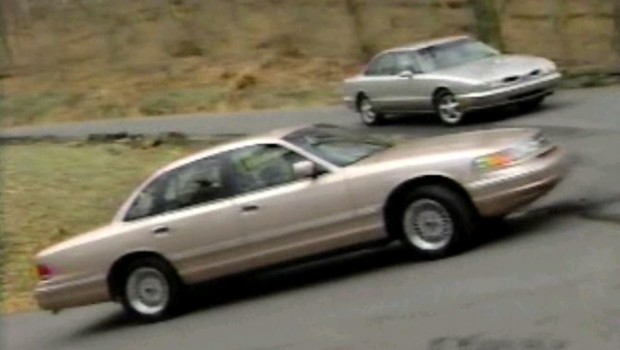
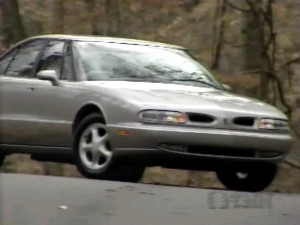
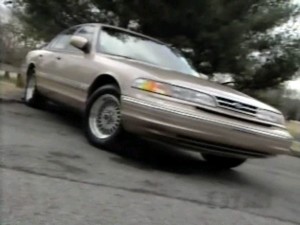
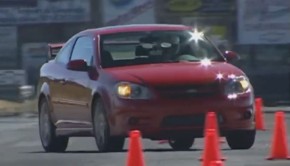
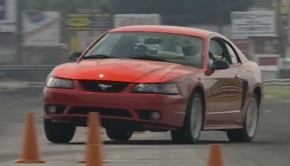
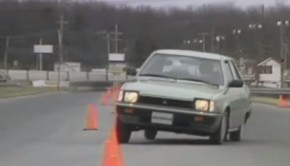
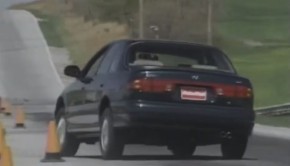





Crown Vic all day long.
I own a 1999 crown victoria and it’s red and I just live that car it’s got 89k but I don’t care it runs and that’s all I care about.
This is a long response so please skip if you do not with to read it!
In this video, as with most reviews of cars or trucks nowadays it seems that logical thinking is abrogated by sloppy analysis, warped by feelings and the usual “car guy” emphasis on handling and power over ruggedness and trouble free ownership. As far as handling goes the Crown Vics with the Sport packages (Handling and Performance Packages & later the Crown Victoria LX Sport models for example) handled pretty well & had a few extra hp included. If they were going to compare the vehicles this would be the appropriate Crown Vic to order.
1.) From the very beginning this review started on the wrong foot by stating that after the 1996 model year, the Ford Crown Victoria was “the sole remaining family sedan with rear wheel drive”. That was not true. There was the two sister cars from Ford Motor Company called the Mercury Grand Marquis, and also the Lincoln Town Car that were produced beyond 1996 model year in the US. (Yes I know the Lincoln was considered a luxury car but it is based on the same “Panther” platform used by the Crown Vic and the Grand Marquis.)
2.) Not mentioned was the fact that all the Panther cars in 1996 offered a from-the-factory-5000 lb tow package. For comfortable cruising while pulling a 5,000 lbs trailer, these were the cars to get in 1996 along with the 3 remaining full sized rear drive cars from GM for the 1996 model year (the Cadillac/Buick/Chevrolet) which also had 5,000 lb tow packages. After 1996 Ford cancelled the 5000 lb tow package to try and force owners to buy pickup trucks and sport utilities which returned even more per vehicle profit to Ford Motor Company. However this meant that Ford passed up the opportunity to dominate car based class III towing capability. This is also an indication that competition improves the breed since Ford only cancelled the tow package after their GM competition disappeared. But recall that Ford essentially did not advertise the fact that these Panther cars could tow serious loads helping to push more people into the truck lines. Nothing wrong with making a profit but Ford already had the tow package available and could have easily kept it as an option. As people were already beginning to gravitate toward big pickups and sport utilities I can understand the motivation to keep profits humming at Ford but if they had done some advertising marketing they would have certainly cornered the market on car based towing. These packages typically included things like heavy duty springs/shocks/driveshaft/universal joints/flasher/power steering cooler/extra transmission cooler/oil cooler/etc. Since Ford already had 4 wheel disc brakes on these vehicles by 1996 it was not necessary to add heavy-duty brakes (like they did with the older Class III tow packages in the 1970s and 1980s when the rear drums (they did not have 4 wheel discs back then) were beefier. The same with the alternator which had been beefed up and the power steering coolers (which were on the handling package cars). Thus what I am saying is that it would have been easy to add these components to the vehicles since some of the components were already on the vehicles or optionally available (as on the Crown Victoria LX Sport of later years). I understand the bean counter mentality as a savings here and there can add to Ford (or any companies) profits if it is applied wisely. But if Ford had advertised the tow package anywhere or at least mentioned it as a major feature in brochures they certainly would have had some greater sales of this rather uncommon option. I used to order the tow package for my Father’s Lincoln Town cars that he bought, even though he did not tow! He just wanted a heavy duty car that was luxurious! Amazingly, many car dealership salesmen did not even know that any of their own cars could tow 5000 lbs back then as I would ask about it at various Metro-Detroit dealerships & they seemed confused until I pointed it out to them. Certainly a good salesman should have knowledge of their own (& competitors) vehicles in order to maximize confidence that they know their own product! This is not only useful to the occasional customer interested in the details/capabilities of the vehicle but it increases the salesman’s own enthusiasm & confidence in the product!
3.) The Ford Crown Victoria also was the foundation for the Police Package (and Taxi Packages) that was ordered by many police departments. The reasons were not explained or even mentioned. Police want a vehicle that is rugged enough to take abuse (rear drive; solid live heavy duty rear axle;body on frame construction; relatively simple drive-train (no CV joints); heavy duty steel wheels; etc), had many from -the-factory heavy duty parts, and was relatively inexpensive to repair. If you ever watch a police car on duty it is not unusual to see a policemen drive the vehicles over parking lot concrete bump stops, push a disabled vehicle off the highway (with the heavy duty police push bumpers attached to the front of the vehicles) or tap a vehicle on the left or right rear corner to get it to spin out (when in pursuit of a criminal). All these actions take their toll on a vehicle (and it is one reason why used police vehicles are often sold at such large discounts) and they need to be rugged if the police department wants to get a lot of car for the money (a major reason why the police choose a vehicle is because it offers a rugged vehicle, that is relatively easy to repair, can be purchased for a relatively low cost, and is reasonably roomy (remember all the equipment that is placed in the trunk of a police car such as road flares, blankets, radio equipment, gloves, first aid kit, shovel rope, a real full sized spare tire & jack, fire extinguisher, bad weather gear, etc) & a place to hold arrested individuals (back seat area usually with a heavy duty divider to protect the officer). It is not unusual for a for a Metro Detroit taxi to be retired after 4-5 years of service with 400,000 or more miles on it & without any major drivetrain concerns after which they are sold & continue their useful life. These points are almost never mentioned in any drivereports about these vehicles but it is a major reason why I prefer my Panther platform vehicles. The intake manifold of the 4.6 Liter V8s used in the Crown Victoria in the 1990s & beyond did have a concern with cracking intake manifolds (this was covered under extended warranty for livery/police/and taxi cab vehicles) that eventually needed replacement. By 2003 model year the 4.6 had a more dependable intake manifold. The taxi & Police vehicles also used a steel spring in the rear instead of the air suspension as the steel springs were simpler, cheaper & more rugged). I myself have replaced the rear air suspensions on my 1996 Lincoln Town car with Police Springs.
4.) Because these vehicle were used for more rugged service applications the overall car was more rugged even in a base model not sold to the police or taxi services.
5.) In addition there were many heavy duty parts available that can be used as replacement parts on these vehicles. For example, I ordered the police springs from the Crown Victoria police package for my 1996 Lincoln Town Car which bolt right in place along with hd shock absorbers.
6.) These vehicles made billions of $$ in profits for Ford, yet Ford decided not to update them in 2009 or earlier, to add for example a 5 or 6 speed automatic transmission, or a more powerful engine. More powerful engines were readily available that would fit right into these vehicles in the late 2000s that would offer 280 hp on regular gas or 300 or more on premium. (see Mustang’s 320 hp 4.6 liter in 2010 for example). It may have been a wise move by Ford to get more people into trucks but there is an opening today for a vehicle that is similar to the Crown Victoria in roominess & can tow 5,000 lbs. Think about it. In an analogy, today even the very large “mid-sized” pickups from GM (Canyon & Colorado) & the upcoming trucks from Ford (the new 2019 Ranger) are designed to force an owner into an even larger pickup truck for no reason. These mid sized trucks today are close to the size of full-sized trucks from 20 years ago & yet none of them come with even a 7 foot long inner bed length that even the older compact older trucks weighing 500 pounds less would offer such as my 1997 Ranger (7’ 4” bed length). Thus there is an opening for a competitor to offer such a truck with a longer bed & smaller than the new giant sized compact trucks. Just as there is room for a competitor to build a new 4 door sedan with 1-2 inch higher ground clearance (about 6-7 inches of clearance), a couple inches of greater headroom & damn good exterior style) This would complete with all the 4 door pickups (which are being used more & more as replacements for traditional rear drive family sedans), as well as competing with sport utilities since they would be almost as roomy for passengers, have a little higher ground clearance (for easier exit & entry since by the 1960s cars were getting lower than ideal for easiest entry & exit) & yet move a little better in snow & rugged terrain which keeping an attractive 3 box (hood-passenger compartment-trunk) style. Since so many trucks are so large today it would not be hard to style an attractive car for family use & utilizing the same ideas for big grills that today’s trucks use. It would rather be like a new version of an early 50s sedan in style (big powerful grills & flowing side lines) & roominess but obviously with today’s safety, quality, efficiency & comfort features & benefits.
7.) The weaknesses of the Crown Victoria vs the Olds were of course the power —even when equipped with the optional 210 hp 4.6 L V8, the 3.8 supercharged Buick engine in the Olds was quite a bit faster. The advantages of front wheel drive in the snow & slippery surfaces is also evident but is abrogated if the owner places real snow tires on the Crown Vic for Winter driving (as I have done on separate rims on my Lincoln). The overall durability & ruggedness of the Crown Vic are the sterling qualities in my book. It is more rugged, more long lived, has police/taxi car roots, is generally somewhat easier to service & repair, & can tow 5000 lbs when properly equipped. This does not mean the Olds was not a better car if you valued tighter exterior dimensions, a bit better gas mileage, & valued the front drive (you did not want to change the tires on the car to snow tires during winter), & regularly used or just wanted the added power, at the expense of ultimate ruggedness, longevity, simplicity, & hd parts available for the Ford.